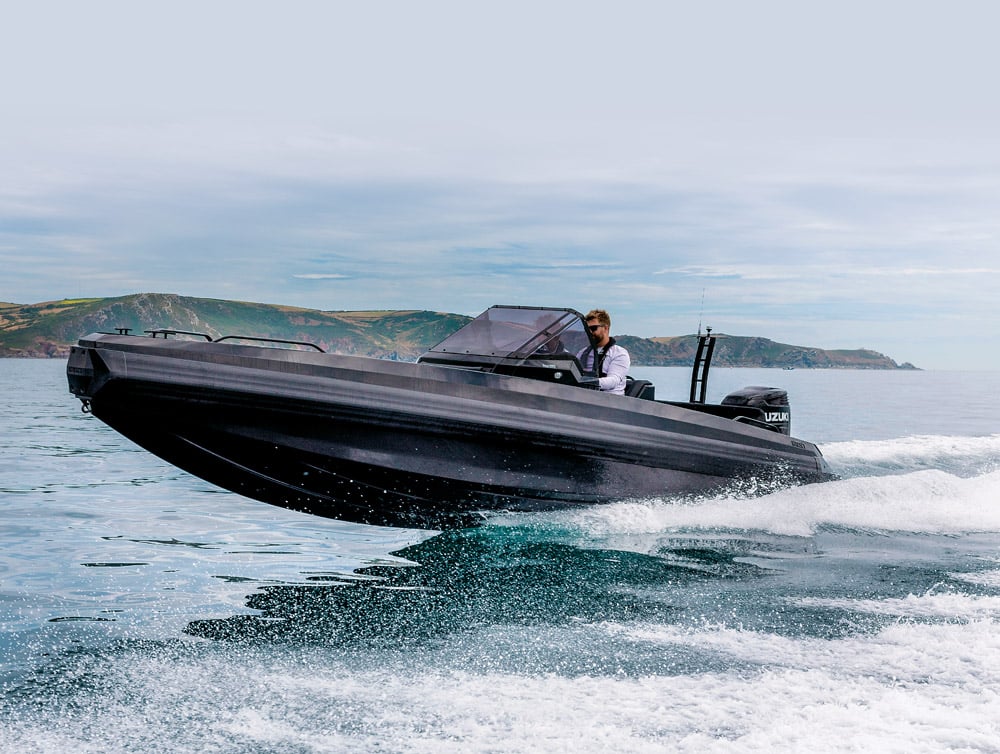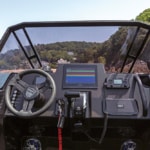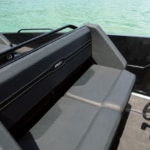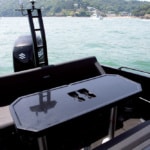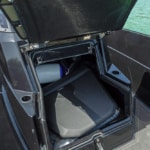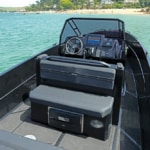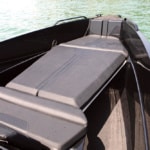HMS heads to Salcombe to test The Wolf Rock Boat Company’s latest offering, the Scandinavian-built IRON Boat. The first UK test of its kind, this much anticipated new ‘adventure’ brand boasts a world-class hull and no-nonsense looks …
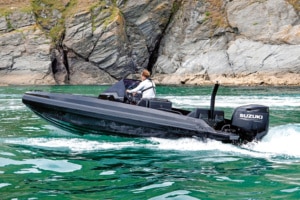 The Scandinavian boatbuilding industry in particular has a strong adventure boating ethos at its heart, with many brands possessing a reputation for being robust and well suited to all-year-round boating. This is no less the case with the Scandinavian-built IRON Boat brand – a new breed of craft developed by Lars and Henrik Peterson, two brothers who have a long family association with adventuring along the beautiful, but often harsh, west coast of Sweden. Drawing upon their combined experience, it would appear that the Peterson brothers are coming at this from the perspective of being lifelong owners and enthusiasts themselves. Nevertheless, taking the decision to involve the likes of Ocke and Ted Mannerfelt – world-renowned designers and naval architects in their own right – is a smart move because from the get-go, the IRON Boat has been afforded ‘pedigree’ status.
The Scandinavian boatbuilding industry in particular has a strong adventure boating ethos at its heart, with many brands possessing a reputation for being robust and well suited to all-year-round boating. This is no less the case with the Scandinavian-built IRON Boat brand – a new breed of craft developed by Lars and Henrik Peterson, two brothers who have a long family association with adventuring along the beautiful, but often harsh, west coast of Sweden. Drawing upon their combined experience, it would appear that the Peterson brothers are coming at this from the perspective of being lifelong owners and enthusiasts themselves. Nevertheless, taking the decision to involve the likes of Ocke and Ted Mannerfelt – world-renowned designers and naval architects in their own right – is a smart move because from the get-go, the IRON Boat has been afforded ‘pedigree’ status.
Earlier this summer, PBR was given the opportunity to undertake the very first UK test of the IRON, in particular the 767 model, which, as the pictures show, is essentially a RIB derivative. So, what did we make of her?
Inner space
If you’re looking for a 7m category boat with a generous amount of storage, the IRON 767 scores highly. Locker space can be found throughout the vessel’s anatomy, and a fair proportion of the stowage it affords gives every indication of being dry. However, the voluminous locker beneath the lazarette needs the addition of a simple net or an internal liner to prevent those items placed inside falling to the back of the space and into the bilges. Also, because the design of the lazarette’s hinged, upholstered seat base restricts the degree to which it can be opened/lifted, you’re unable to get your arm down into the cavity very far. Items placed in here will be difficult to reach as a result. The lazarette, though, does offer generous and comfortable seating for three/four and can be used at speed too, with its GRP side panels providing passengers with lateral security. The grab rails to the top of the gunwales either side are a bit of a stretch, however, and can only be reached when sitting on the outer extremity of the seat.
A fair percentage of similar-sized craft on the market these days feature a toilet compartment within the forward section of their helm console. At this present time, the IRON does not offer this facility, but instead, this unit is left free for additional storage as well as housing the vessel’s electrical system and its associated batteries, etc. Access to the dry storage interior is gained via a straightforward lifting of the handle located to the base of the console’s Silvertex-upholstered double bench seat. The seat itself, with its inset, padded back support, is comfortable and well suited to moderate speed use but does lack handholds. Either side of the helm unit, a generously wide companionway is provided to enable easy access fore and aft. Up in the foredeck, an optional infill can be slotted in to turn the entire area into a sunbed. Ahead of this, right up the GRP nose of the boat is one of the most spacious and accessible anchor lockers I’ve found on a boat of this type. The foredeck itself is split-level, with the forward area forming a giant deck locker. Skis and other larger items can all be housed within this useful additional stowage area.
- The 767’s F1 fighter styled cockpit and screen, complete with Garmin electronics.
- The spacious adjustable 2-person helm seat.
- A modern approach to a drop-in, pull-out aft deck table.
The 767 cockpit
Moving now to the cockpit, the helm console’s dash, with its port-side driving position, features an array of flush-mounted Garmin electronics plus a high-quality offshore binnacle compass. The latter is good to see as many boats these days simply don’t include a compass at all! The colour-matched, 3D printed fascia, shaped to the face of the dash, enhances the instrument display and contributes toward the modern appearance of the helm. The branded sports wheel, Mercury throttle lever, main switch panel, and VHF and Fusion sound system controller are all thoughtfully placed, and as a consequence, from a driving perspective, the IRON 767’s ergonomics are very good indeed.
The helmsman and navigator will feel secure at their positions within the cockpit and benefit from a good amount of protection being granted them by the large, rearward-raked, tinted screen. The latter is strongly made, offers good protection and has the air of an F1 fighter canopy about it. For the navigator, the combination of the full-width footplate coupled to a sturdy, dashboard-mounted grab handle provides the ability to brace oneself securely at speed. I will add one observation about the footrest though; namely, that the inset Fusion waterproof speakers are located just above the footrest. This might make the speaker grills vulnerable to being inadvertently kicked.
Legroom is generous between the steering position and the helm seating unit. Being adjustable, these seats can be positioned for either sitting or standing, with the latter offering bolster support in the ‘up’ position. However, the seat pad could benefit from a little more padding in my view, and its associated backrest possesses a hard ridge that would also benefit from a little modification. To the rearward face of the central seating unit, there is a comfortable two-person bench seat that features a small slide-out fridge within; at present, the interior voids of the unit either side of the fridge are not utilised. Unlike the forward-facing helm seats that offer lateral bracing, the rearward bench seat has no sides, but the metal handrail that extends the full length of the seat top does provide a good grab point. Further aft again, the deck area between the rearward-facing seat unit and the lazarette takes a modern-styled drop-in table to enhance socialising when the vessel is at rest.
On deck
Stepping out onto the transom deck/bathing platforms either side of the engine is effortless. And thanks to the stylish yet functional design of the powder-coated metal stern mast carrying the vessel’s antennas and anchor light, you can steady yourself as you step over and onto this area. It’s a great addition to the 767’s anatomy and not only provides a very welcome boarding area for swimmers, but also a useful working platform to access the engine cowling while afloat.
The test boat’s deck surfaces are finished in colour matched Vendeck marine non-skid laminate. Going forward however, Wolf Rock will be fitting out these craft with SeaDeck, a modern deck surfacing solution which is immensely hard-wearing, offers all manner of CNC customisation and colour option benefits and of course, by manner of its lightweight laminate constitution, provides great weight-saving and maintenance advantages over traditional teak.
- The super-sized helm console locker.
- Stern facing bench seat with a neat fridge underneath.
- The 767’s sun-lounging capability.
Behind the wheel
When taking the wheel of the IRON 767, it takes no time at all to determine the class of hull beneath one’s feet. Upon getting ‘up and away’, you immediately feel the hull generating lift and straight-as-a-die directional stability. Undoubtedly, the boat’s Mannefelt designed hull is its greatest accolade. Issuing from a world-class design team such as this, fast-tracks the IRON model range into the performance league where even the most experienced driver is unlikely to ever feel short-changed. But as you might expect, the 767 is not simply intended for those with high-performance powerboating experience – not at all. The hull and the corresponding design of the vessel’s other key attributes are all about instilling driver confidence. Above all, this is a safe boat, and as a consequence it will not present its occupants with any nasty surprises at speed if, like any high-powered craft, it’s treated with respect. Speaking for the standpoint of a boat tester, when determining the hydrodynamic attributes of a hull, you’re not looking for top-speed performance alone. Just as importantly, you’re seeking to ascertain the hull’s predictability, its sure-footedness and, of course, the boat’s ‘sea-kindly’ attributes. In all these areas, the IRON 767 scores highly.
I admit that we experienced a fair degree of propeller cavitation on the day of the test (as a consequence of the boat having only just arrived in the UK and the Wolf Rock team’s haste in trying to make the boat available to us) – all the same, I have no reason to doubt that this issue will be fully sorted by the time the boat’s made available for customer demonstration. Besides, the Wolf team of in-house technicians are thorough and know what they’re doing. But putting this niggle aside, the boat easily achieved a satisfying 50mph, and there’s little doubt that with more time available to fine-tune the rigging of the engine, the 767 and its Suzuki DF250 power pack will deliver even more top-end performance. The 767 is a boat that comes up onto the plane smartly and runs entirely level, and it responds well to the trim and grips to the water without any unwarranted side slipping of the hull when put into a hard lock.
Besides making a very capable family inshore boat, the IRON would also take cross Channel cruising and extended coastal voyaging in its stride. In this sense, its versatility is clear. My preference, however, would be to see even larger diameter scuppers installed, because with any high-gunwaled craft of this type, if in the unlikely event you were to take a green sea, the volume of water could be considerable, so you’d be wanting to shift it as quickly as possible. Meanwhile, however, the present size of scupper complies with the vessel’s CAT C rating.
Conclusion
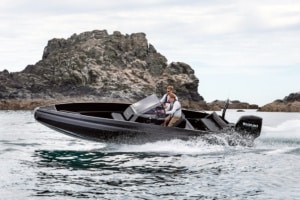 The IRON 767 is a boat with attributes that offer something different in the way of appearance. Its design is imaginative, and I anticipate it will have no shortage of admirers. The all-black livery of the test craft will no doubt have particular appeal with a male audience, but I’m told that other colour combinations are in the pipeline too. This includes a white version of the 767, which is due to make its debut alongside its other IRON Boat stablemates, within Wolf Rock’s considerable landside display at this year’s Southampton Boat Show. I’m looking forward to seeing this and to what degree this colour option may affect the feel and character of the IRON.
The IRON 767 is a boat with attributes that offer something different in the way of appearance. Its design is imaginative, and I anticipate it will have no shortage of admirers. The all-black livery of the test craft will no doubt have particular appeal with a male audience, but I’m told that other colour combinations are in the pipeline too. This includes a white version of the 767, which is due to make its debut alongside its other IRON Boat stablemates, within Wolf Rock’s considerable landside display at this year’s Southampton Boat Show. I’m looking forward to seeing this and to what degree this colour option may affect the feel and character of the IRON.
The Wolf Rock Boat Company have a first-class reputation for establishing and investing in the products they represent. I don’t doubt that they will do very well with IRON, and furthermore, it will be interesting to see what influences their experience and input have on this Scandinavian-made 4-boat model range in the months to come. Meantime, even the fully spec’d 767 is a keenly priced product when compared to other craft of this size and genre. Being such a capable and comprehensibly fitted out craft, the IRON offers quite a tempting option in my view.
Specifications
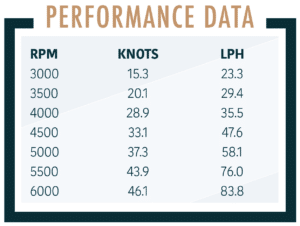 Length: 7.72m
Length: 7.72m - Beam: 2.44m
- Height: 1.5m (above waterline)
- Draught: 0.8m
- Hull deadrise: 23° at transom
- Weight: 1300kg
- Max. persons: 8
- Max. load: 960kg
- CE class: C
- Fuel tank: 262L (stainless)
- Power options: 200–300 hp
Other models
Other models in the Swedish-built IRON Boat range, besides the 767 tested by PBR, include a 647, 707 and 827 model.

